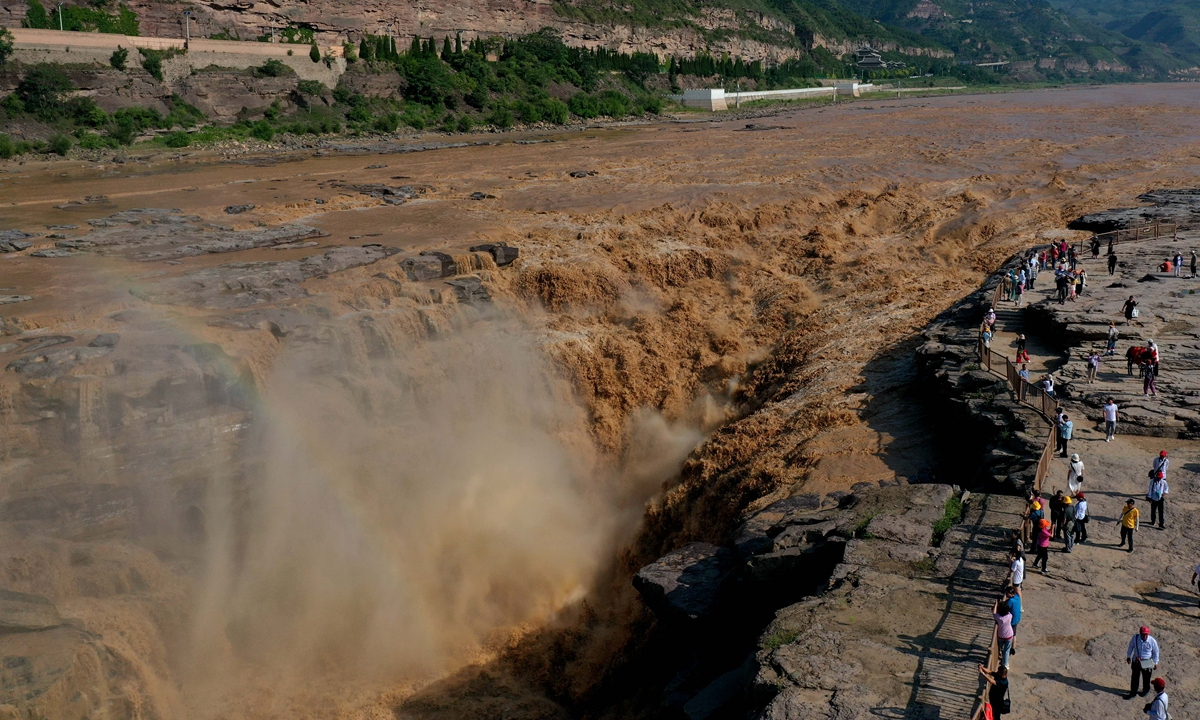
Tourists view the scenery at the Hukou Waterfall on the Yellow River in Linfen, North China's Shanxi Province on June 29, 2023. Located on the border between Shanxi and Northwest China's Shaanxi Province, the Hukou Waterfall is the largest waterfall on the Yellow River, the second largest waterfall in the country and the world's largest yellow waterfall. Photo: VCG
Chinese archaeologists have discovered more than 150 Paleolithic sites along one of the branches of Yellow River, tracing the history of ancient human activities in the region back to about 600,000 years ago, according to the Shaanxi Provincial Cultural Heritage Administration on Sunday. Experts say the discovery once again proves the profound continuous nature of Chinese civilization.
Luo Wenli, head of the administration, told the Global Times on Monday that the continuous development and inheritance of stone tool-making technologies exhibited by ancient humans in this region further confirm China's continuous human developmental history covers hundreds of thousands of years.
According to the administration, more than 150 Paleolithic sites have been discovered on the west bank of the Yellow River, as well as its tributaries, since 2019. The diverse range of stone tool technologies revealed a vivid picture of the continuous existence and development of ancient humans from over 700,000 years ago to around 10,000 years ago.
In 2022 and 2023, Chinese archaeologists found Paleolithic sites along the Shichuan River in Northwest China's Shaanxi Province, filling a gap in the distribution of Paleolithic sites in the central region around the northern Weihe River, one of Yellow River's branches.
Zhang Gaike, an archaeologist who participated in the project, told the Global Times on Monday that rich stone artifacts from a period spanning 600,000 to 30,000 years ago were found at the Miaogou site in Shaanxi Province, pushing human activities in this area back to about 600,000 years ago.
"Geologists have dated the soil, and the fifth layer of loess comes from 470,000 to 600,000 years ago," he said.
The Zhuhuangbao site in Shaanxi Province yielded more than 7,000 stone artifacts from multiple continuous cultural layers dating from 130,000 to 40,000 years ago. These artifacts exhibited significant transitional characteristics of Middle to Late Paleolithic cultures, providing valuable data for constructing an evolutionary sequence of Paleolithic culture in the middle reaches of the Yellow River.
In 2021 and 2022, excavations along the downstream section of the Yellow River uncovered sediment deposits that were up to 24 meters thick. This discovery revealed an ancient human cultural heritage spanning from more than 1 million years to approximately 30,000 years ago, forming a nearly continuous record.
According to Luo, important fossil remains of ancient humans such as the Lantian Man and Dali Man were previously discovered in Shaanxi, establishing a relatively complete chain of human evolution in China. While the new discoveries mentioned above provide precious new materials for the study of ancient cultures in the Yellow River Basin.
Zhang said the report is the conclusion to five years of archaeological work along the Yellow River. In the next phase, the Chinese archaeological team will continue to investigate and conduct in-depth excavations on key archaeological sites along the Yellow River.
The Yellow River, the "Mother River" of the Chinese nation, is the second-longest river in China, spanning 5,464 kilometers. The river supplies water to 12 percent of China's population in more than 50 cities and irrigates 17 percent of the country's arable land, according to the Xinhua News Agency.
URL: https://www.seeglobalnews.com/read-1857.html